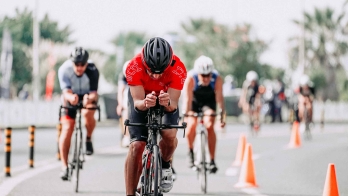The best Apple Health metrics for cyclists
From blood oxygen to sleep tracking, Apple Health offers critical information that can help cyclists measure and analyze their health, strength, and endurance levels to ultimately improve performance. However, the amount of information provided can be overwhelming. This article details the most useful metrics in Apple Health for cyclists.

Apple Health is one of the most used apps for active individuals and athletes, but the vast amount of data available can be overwhelming. Knowing which metrics to focus on can help cyclists understand and document their stats, customize training sessions, and improve athleticism both on and off the bike.
What is Apple Health?
Apple Health is an iPhone app that automatically tracks distance, steps, and other metrics by using the phone’s built-in accelerometer. It syncs up with Apple Watch to track fitness levels and provide helpful metrics for athletes and non-athletes alike.
When you wear the watch during a ride, you can keep track of important metrics (such as distance, speed, heart rate, heart rate variability, elevation gain, and calories burned), as well as sleep and environmental sound levels. You also have the ability to integrate data with other popular fitness products and apps such as Strava, Peloton, and Garmin, allowing for even more data analysis and sharing across platforms.
Apple Watch is a great tool for cyclists because it allows you to track rides, set goals, and see metrics (both on and off the bike). To track a ride, simply select Outdoor Cycle from the Workout menu on the app (or select Indoor Cycle if you are on a stationary bike). From there you can select a goal based on distance, time, or calories, or choose an open goal. You can also measure elevation, heart rate, and speed with the Apple Watch.
This tool is also beneficial for when you’re not training, you can collect data on heart rate variability (HRV), sleep, and resting heart rate. These metrics will not only help you assess performance, but it will also aid in recovery and your readiness to train.
Heart rate
Apple Watch monitors your heart rate continuously throughout a workout, and will continue to measure for three minutes after the end of a workout to determine a recovery rate. It uses green LED lights paired with light-sensitive photodiodes to detect the amount of blood flowing through your wrist [ 10 10 heart rate variability
Resting heart rate
Resting heart rate (RHR) is one of the most basic measures of health and fitness. Having a lower resting heart rate is associated with better cardiovascular health outcomes and an extended life expectancy [ 1 1
Your resting heart rate can also determine recovery levels and alert you to potential overtraining. If you notice a resting heart rate that is higher than your average, you may not be fully recovered from a hard workout or ride. An elevated RHR may signal you to take a rest day, while a lower RHR may indicate increased readiness to perform at your best [ 2
Heart rate variability
Though less popular than resting heart rate, heart rate variability (HRV) is an important measure of health and fitness. HRV is defined as a measure of variation in time between heart beats and comes from simultaneous influences from the parasympathetic and sympathetic nervous systems. Your sympathetic nervous system (also known as “fight or flight”) causes the heart rate to increase, while your parasympathetic nervous system (also known as “rest and digest”) causes your heart to beat slower. These competing systems result in heart rate variability [ 3
Like resting heart rate, HRV can be used to assess training levels and gauge recovery. A higher HRV can be used as an indicator to train more or give your maximum effort [ 4
HRV is highly individualized and dependent on several factors, including training volume and intensity, nutrition, alcohol intake, sleep, stress, age, gender, and genetics [ 5
VO2 max
VO2 max is defined as the maximum amount of oxygen utilized by the body during periods of exercise [ 6 6 7
VO2 max values can be used to assess your progress during a training cycle. The best way to improve your VO2 max is by incorporating higher intensity workouts and alternating between continuous and interval training. Apple Watch uses watch sensors like the heart rate monitor and accelerometer to calculate VO2 max [ 10
Exercise minutes
One of the more basic metrics you can get from Apple Health is exercise minutes. Every minute of movement that is equal to or exceeds the intensity of a brisk walk will contribute towards your exercise minutes and this is a great way to keep a log of your total cycling and training time.
For adults, physical activity recommendations are at least 150-300 minutes per week of moderate intensity or 75-150 minutes per week of vigorous-intensity aerobic physical activity, plus muscle-strengthening exercises at least twice a week [ 8
Blood oxygen
The latest Apple Watch model (Series 6) is equipped with a blood oxygen sensor and app, providing you with data on oxygen saturation. This metric represents the percentage of oxygen bound to hemoglobin in your blood. It works by emitting red and green LED and infrared light onto your wrist and measuring the light reflected back. This can be used to determine the color of your blood and give an accurate reading: the brighter the blood, the more oxygen available, and conversely, the darker the blood, the less oxygen available [ 11
Understanding your blood oxygen levels is especially helpful for cyclists training at altitude, as the air at higher elevation has a lower concentration of oxygen than at sea level, resulting in less oxygen in your bloodstream. Moreover, a drop in blood oxygen can indicate worsening asthma or anemia. Checking your blood oxygen levels can help prevent overtraining, and help track your progress in acclimating to altitude [ 9
Sleep tracking
Sleep is another useful Apple Health metric for cyclists, as proper rest is crucial for performance and recovery. Sleep features available in Apple Health include monitoring sleep trends, setting bedtime hours, and updating your sleep goals. Moreover, Apple Health integrates with Apple Watch, Oura and other sleep trackers for cyclists who want more granular information about sleep quantity and quality to improve performance and assess readiness to train.
Summary
For cyclists looking to monitor their progress, develop a training plan, log rides, and prevent overtraining, Apple Health provides a wide variety of helpful metrics. Understanding key metrics such as resting heart rate, heart rate variability, VO2 max, exercise minutes, and blood oxygen, can help determine your overall fitness level and inform future training plans. While the data from Apple Health is not always 100% accurate, the app provides numbers and trends that can be used to assess readiness to train as well as training progress. Learning more about your cardiovascular and overall health is key to becoming a stronger, faster, healthier cyclist.
Disclaimer: The text, images, videos, and other media on this page are provided for informational purposes only and are not intended to treat, diagnose, or replace personalized medical care.
Key Takeaways
Resting heart rate (RHR) helps determine your recovery levels and alerts you to potential overtraining.
Since proper rest is crucial for performance and recovery, cyclists can track sleep minutes and sleep quality to improve performance.
Higher VO2 max levels tend to be positively influenced by high intensity exercise, such as cycling [
6
,7
].Cyclists can track daily and weekly exercise minutes to help prevent overtraining.
Knowing your blood oxygen levels is especially helpful for cyclists training at altitude [
9
].
References
Reimers, A. K., Knapp, G., & Reimers, C. D. (2018). Effects of Exercise on the Resting Heart Rate: A Systematic Review and Meta-Analysis of Interventional Studies. Journal of clinical medicine, 7(12), 503.
https://doi.org/10.3390/jcm7120503
Schneider, C., Hanakam, F., Wiewelhove, T., Döweling, A., Kellmann, M., Meyer, T., Pfeiffer, M., & Ferrauti, A. (2018). Heart Rate Monitoring in Team Sports—A Conceptual Framework for Contextualizing Heart Rate Measures for Training and Recovery Prescription. Frontiers in Physiology, 9.
https://doi.org/10.3389/fphys.2018.00639
Singh, N., Moneghetti, K. J., Christle, J. W., Hadley, D., Plews, D., & Froelicher, V. (2018). Heart Rate Variability: An Old Metric with New Meaning in the Era of using mHealth Technologies for Health and Exercise Training Guidance. Part One: Physiology and Methods. Arrhythmia & electrophysiology review, 7(3), 193–198.
https://doi.org/10.15420/aer.2018.27.2
Javaloyes, A., Sarabia, J. M., Lamberts, R. P., & Moya-Ramon, M. (2019). Training Prescription Guided by Heart-Rate Variability in Cycling, International Journal of Sports Physiology and Performance, 14(1), 23-32.
https://doi.org/10.1123/ijspp.2018-0122
Singh, N., Moneghetti, K. J., Christle, J. W., Hadley, D., Froelicher, V., & Plews, D. (2018). Heart Rate Variability: An Old Metric with New Meaning in the Era of Using mHealth technologies for Health and Exercise Training Guidance. Part Two: Prognosis and Training. Arrhythmia & electrophysiology review, 7(4), 247–255.
https://doi.org/10.15420/aer.2018.30.2
Scribbans, T. D., Vecsey, S., Hankinson, P. B., Foster, W. S., & Gurd, B. J. (2016). The Effect of Training Intensity on VO2max in Young Healthy Adults: A Meta-Regression and Meta-Analysis. International journal of exercise science, 9(2), 230–247.
Strasser, B., & Burtscher, M. (2018). Survival of the fittest: VO2max, a key predictor of longevity?. Frontiers in bioscience (Landmark edition), 23, 1505–1516.
https://doi.org/10.2741/4657
Yang Y. J. (2019). An Overview of Current Physical Activity Recommendations in Primary Care. Korean journal of family medicine, 40(3), 135–142.
https://doi.org/10.4082/kjfm.19.0038
Mairbäurl, H. (2013). Red blood cells in sports: Effects of exercise and training on oxygen supply by red blood cells. Frontiers in Physiology, 4. https://doi.org/10.3389/fphys.2013.00332
Monitor your heart rate with Apple Watch. Apple Support. (2021, June 2).
https://support.apple.com/en-us/HT204666
.How to use the Blood Oxygen app on Apple Watch Series 6. Apple Support. (2020, October 28).
https://support.apple.com/en-us/HT211027






